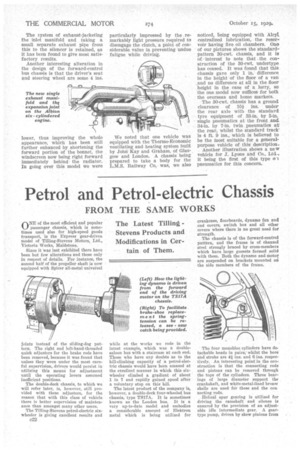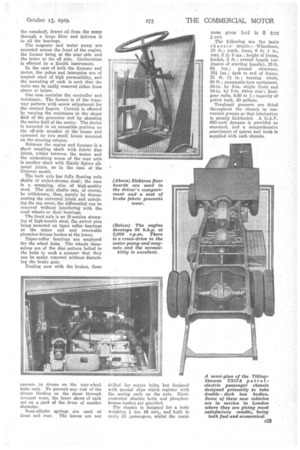Petrol and Petrol-electric Chassis
Page 60

Page 61

If you've noticed an error in this article please click here to report it so we can fix it.
FROM THE SAME WORKS
The Latest Tilling Stevens Products and Modifications in Certain of Them.
ONE of the most efficient and popular passenger chassis, which is sometimes used also for high-speed goods transport, is the Express gear-driven model of Tilling-Stevens Motors, Ltd., Victoria Works, Maidstone.
Since it was last exhibited there have been but few alterations and these only in respect of details. For instance, the gecond half of the propeller shaft is now equipped with Spicer all-metal universal joints instead of the sliding-dog pattern. The right and left-hand-threaded quick adjusters for the brake rods have been removed, because it was found that unless they were under the most careful supervision, drivers would persist in utilizing this means for adjustment until the operating levers assumed inefficient positions.
The double-deck chassis, to which we will refer later, is, however, still provided with these adjusters, for the reason that with this class of vehicle there is better supervision of maintenance than amongst many other users.
The Tilling-Stevens petrol-electric sixwheeler is giving excellent results and
while at the works we rode in the latest example, which was a doublesaloon bus with a staircase at each end. Those who have any doubts as to the hill-climbing capacity of a petrol-electric chassis would have been amazed at the excellent manner in which this sixwheeler climbed a gradient of about 1 in 7 and rapidly gained speed after a voluntary stop on this hill.
The latest product of the company is, however, a double-deck four-wheeled bus chassis, type TS17A. It is sometimes known as the London bus. It is a very up-to-date model and embodies a considerable amount of Elektron metal which is being utilized for crankcase, floorboards, dynamo fan and end covers, switch box and all other covers where there is no great need for strength. • The chassis is of the forward-control pattern, and the frame is of channel steel strongly braced by cross-members which have large gussets formed solid with them. Both the dynamo and motor are suspended on brackets mounted oi the side members of the frame.
The four monobloc cylinders have detachable heads in pairs, whilst the bore and stroke are ft ins. and 6 ins. respectively. An interesting point in the construction is that the connecting rods and pistons can be removed through the tops of the cylinders. Three bearings of large diameter support the crankshaft, and white-metal-lined bronze shells are used for these and the con. fleeting rods.
Helical spur gearing is utilized for driving the camshaft and silence is ensured by the provision of an adjustable idle intermediate gear. A geartype pump, driven by skew pinions from the camshaft, draws oil from the sump through a large filter and delivers it to all the bearings.
The magneto and water pump are mounted across the front of the engine, the former being at the near side and the latter at the off side. Carburation is effected by a Zenith instrument.
In the case of both the dynamo and motor, the yokes and interpoles are of magnet steel of high permeability, and the mounting of each is such that the units can be easily removed either from above or below.
One case contains the controller and resistance. The former is of the tramway pattern with screw adjustment for the contact fingers. Control is effected by varying the resistance in the shunt field of the generator and by shunting the series field of the motor. The device is mounted in an accessible position on the off-side member of the frame and operated by two small levers mounted on the steering column.
Between the engine and dynamo is a short coupling shaft with fabric disc joints, whilst between the motor and the underslung worm of the rear axle is another shaft with Hardy Spicer allmetal joints, as in the case of the Express model.
The back axle has fully floating axle shafts of nickel-chrome steel ; the case is a stamping, also of high-quality steel. The axle shafts can, of course, be withdrawn, then, merely by disconnecting the universal joints and unbolting the top cover, the differential can be removed without interfering with the road wheels or their bearings.
The front axle is an H-section stamping of high-tensile steel, the swivel pins being mounted on taper roller bearings at the upper end and renewable phosphor-bronze bushes at the lower.
Taper-roller bearings are employed for the wheel hubs. The wheels themselves are of the disc pattern bolted to the hubs in such a manner that they can be easily removed without disturbing the brake gear.
Dealing now with the brakes, these operate in drums on the rear-wheel hubs only. To prevent any risk of the drums binding on the shoes through unequal wear, the inner shoes of each act on a part of the drum of smaller diameter.
Semi-elliptic springs are used at front and rear. The leaves are not drilled for centre bolts, but desigued with special clips which register with the spring nads on the axle. Hardened-steel shackle bolts and phosphorbronze bashes are provided.
The chassis is designed for a body weighing 1 ton 16 cwt, and built to carry 52 passengers, whilst the maxi
mum gross had iS tsnz.
cwt.
The following are tha inain eh assis details :--Wheelbase, 16 ft.; track, front, 6 ft. 1 in., rear, 5 ft. 9 ins. ; height of frame, loaded, 2 ft.; overall length (exelusive of starting handle), 25 ft.
6-1 ins, ; ground clearance,
10/ ; dash to end of frame, 21 ft. 11, in.; turning circle, 60 ft.; pneumatie-tyre equipment, .36-in. by 8-in, single front and 34-in. by 7-in, twins rear; finalgear ratio, 9.66 to 1; capacity of petrol tank, 30 gallons.
Tecaleinit greasers are fitted throughout the chassis in convenient groups so that lubrication is greatly facilitated. A C.A.V. 600-watt dynamo is provided as standard, and a comprehensive ,assortment of spares and tools is supplied with each chassis,




























































































































